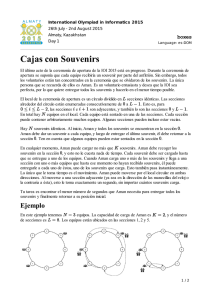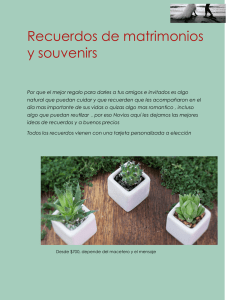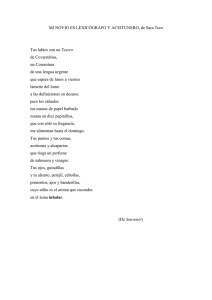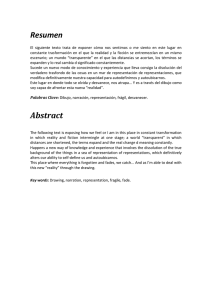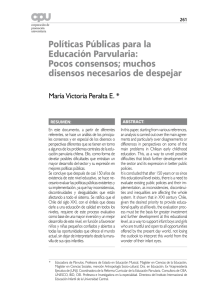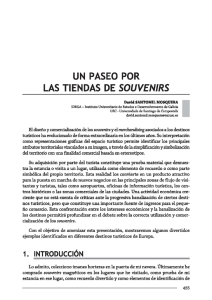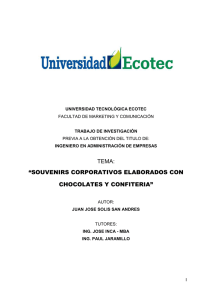algo para recordar - Duccio Canestrini
Anuncio
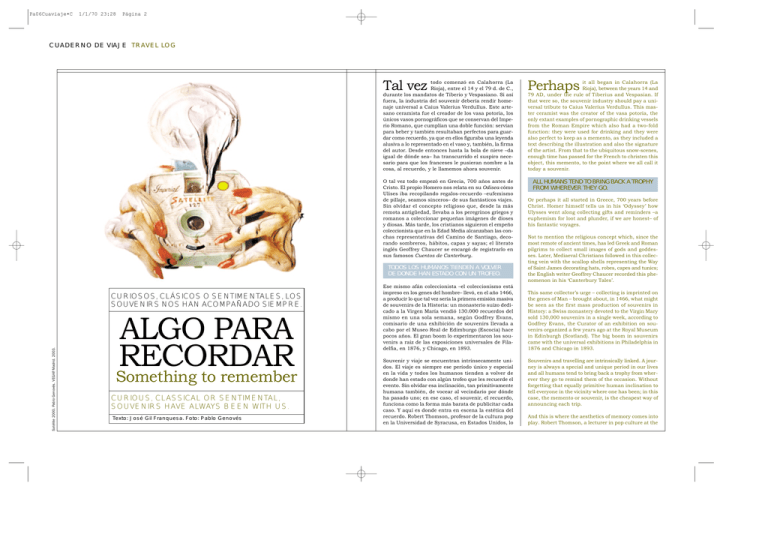
Pa06Cuaviaje•C 1/1/70 23:28 Página 2 CUADERNO DE VIAJE TRAVEL LOG Tal vez todo comenzó en Calahorra (La Rioja), entre el 14 y el 79 d. de C., durante los mandatos de Tiberio y Vespasiano. Si así fuera, la industria del souvenir debería rendir homenaje universal a Caius Valerius Verdullus. Este artesano ceramista fue el creador de los vasa potoria, los únicos vasos pornográficos que se conservan del Imperio Romano, que cumplían una doble función: servían para beber y también resultaban perfectos para guardar como recuerdo, ya que en ellos figuraba una leyenda alusiva a lo representado en el vaso y, también, la firma del autor. Desde entonces hasta la bola de nieve –da igual de dónde sea– ha transcurrido el suspiro necesario para que los franceses le pusieran nombre a la cosa, al recuerdo, y le llamemos ahora souvenir. O tal vez todo empezó en Grecia, 700 años antes de Cristo. El propio Homero nos relata en su Odisea cómo Ulises iba recopilando regalos-recuerdo –eufemismo de pillaje, seamos sinceros– de sus fantásticos viajes. Sin olvidar el concepto religioso que, desde la más remota antigüedad, llevaba a los peregrinos griegos y romanos a coleccionar pequeñas imágenes de dioses y diosas. Más tarde, los cristianos siguieron el empeño coleccionista que en la Edad Media alcanzaban las conchas representativas del Camino de Santiago, decorando sombreros, hábitos, capas y sayas; el literato inglés Geoffrey Chaucer se encargó de registrarlo en sus famosos Cuentos de Canterbury. TODOS LOS HUMANOS TIENDEN A VOLVER DE DONDE HAN ESTADO CON UN TROFEO. Satélite 2000. Pablo Genovés. VEGAP. Madrid. 2003. CURIOSOS, CLÁSICOS O SENTIMENTALES, LOS SOUVENIRS NOS HAN ACOMPAÑADO SIEMPRE. ALGO PARA RECORDAR Something to remember CURIOUS, CLASSICAL OR SENTIMENTAL, SOUVENIRS HAVE ALWAYS BEEN WITH US. Texto: José Gil Franquesa. Foto: Pablo Genovés Ese mismo afán coleccionista –el coleccionismo está impreso en los genes del hombre– llevó, en el año 1466, a producir lo que tal vez sería la primera emisión masiva de souvenirs de la Historia: un monasterio suizo dedicado a la Virgen María vendió 130.000 recuerdos del mismo en una sola semana, según Godfrey Evans, comisario de una exhibición de souvenirs llevada a cabo por el Museo Real de Edimburgo (Escocia) hace pocos años. El gran boom lo experimentaron los souvenirs a raíz de las exposiciones universales de Filadelfia, en 1876, y Chicago, en 1893. Souvenir y viaje se encuentran intrínsecamente unidos. El viaje es siempre ese período único y especial en la vida y todos los humanos tienden a volver de donde han estado con algún trofeo que les recuerde el evento. Sin olvidar esa inclinación, tan primitivamente humana también, de vocear al vecindario por dónde ha pasado uno; en ese caso, el souvenir, el recuerdo, funciona como la forma más barata de publicitar cada caso. Y aquí es donde entra en escena la estética del recuerdo. Robert Thomson, profesor de la cultura pop en la Universidad de Syracusa, en Estados Unidos, lo Perhaps it all began in Calahorra (La Rioja), between the years 14 and 79 AD, under the rule of Tiberius and Vespasian. If that were so, the souvenir industry should pay a universal tribute to Caius Valerius Verdullus. This master ceramist was the creator of the vasa potoria, the only extant examples of pornographic drinking vessels from the Roman Empire which also had a two-fold function: they were used for drinking and they were also perfect to keep as a memento, as they included a text describing the illustration and also the signature of the artist. From that to the ubiquitous snow-scenes, enough time has passed for the French to christen this object, this memento, to the point where we all call it today a souvenir. ALL HUMANS TEND TO BRING BACK A TROPHY FROM WHEREVER THEY GO. Or perhaps it all started in Greece, 700 years before Christ. Homer himself tells us in his ‘Odyssey’ how Ulysses went along collecting gifts and reminders –a euphemism for loot and plunder, if we are honest– of his fantastic voyages. Not to mention the religious concept which, since the most remote of ancient times, has led Greek and Roman pilgrims to collect small images of gods and goddesses. Later, Mediaeval Christians followed in this collecting vein with the scallop shells representing the Way of Saint James decorating hats, robes, capes and tunics; the English writer Geoffrey Chaucer recorded this phenomenon in his ‘Canterbury Tales’. This same collector’s urge – collecting is imprinted on the genes of Man – brought about, in 1466, what might be seen as the first mass production of souvenirs in History: a Swiss monastery devoted to the Virgin Mary sold 130,000 souvenirs in a single week, according to Godfrey Evans, the Curator of an exhibition on souvenirs organized a few years ago at the Royal Museum in Edinburgh (Scotland). The big boom in souvenirs came with the universal exhibitions in Philadelphia in 1876 and Chicago in 1893. Souvenirs and travelling are intrinsically linked. A journey is always a special and unique period in our lives and all humans tend to bring back a trophy from wherever they go to remind them of the occasion. Without forgetting that equally primitive human inclination to tell everyone in the vicinity where one has been; in this case, the memento or souvenir, is the cheapest way of announcing each trip. And this is where the aesthetics of memory comes into play. Robert Thomson, a lecturer in pop culture at the Pa06Cuaviaje•C 1/1/70 23:28 Página 4 CUADERNO DE VIAJE TRAVEL LOG explica de esta forma: ‘Los souvenirs son símbolos de un determinado estatus, a pesar de que sean los símbolos más horteras del mundo’. ¿De verdad son horteras los souvenirs? ¿Son objetos de mal gusto? ¿Es este el símbolo de la estética kitsch? Quién sabe si no es precisamente ahí, en ese grado de mal gusto, donde reside toda la fuerza, o toda la ternura, del souvenir; a pesar de la machacona globalización de los souvenirs mismos: un barco hecho a base de conchas de berberechos y cáscaras de bígaro lo mismo puede pregonar LO MÁS ‘IN’ ‘Recuerdo de Santa Pola’ La bola de nieve es un clásico que ‘Souvenir de Saint-Troen la historia de los souvenirs. pez’. Y casi siempre viene La idea nació en el año 700 y, en un principio, eran imágenes de Oriente, al igual que el religiosas, vírgenes o santos, teléfono Elvis comprado en que se metían en campanas Graceland o la bola de nieve de cristal para preservarlas con un Vesubio llameante. del polvo. Hoy es casi objeto Hay excepciones históricas o tremendamente locales o, simplemente, lugares expoliables: pedazos del muro de Berlín, tras la caída; trozos de la Campana de la Libertad que, cuando dejó de sonar en 1846, fue hecha añicos por los padres de la patria, en Filadelfia, que querían ofrecerlos a sus visitantes ilustres; también piedras del Matterhorn de culto y, como tal, mantiene cierto liderazgo de ventas en tiendas especializadas. Pero le pisa fuerte los talones el caballete de pintor con un cuadro de yeso policromado, en relieve, del sitio en cuestión. En cuanto a su clasificación, los souvenirs pueden encuadrarse en: puramente estéticos (tacita de porcelana blanca, recuerdo de Guadalajara), religiosos (Cristo de Medinaceli en plástico dorado) y estético-funcionales (Il Duomo de Florencia, en pasta imitando mármol, que sirve también para sostener un bolígrafo). University of Syracuse, USA, explains it like this: ‘Souvenirs are symbols of a particular status, despite being the naffest symbols in the world’. Are souvenirs really naff? Are they inherently bad taste? Is this the symbol of kitsch aesthetics? Who can say that it is not precisely there, in the degree of their poor taste, that souvenirs find all their strength, or all their tenderness; despite the irritatingly insistent globalization of the souvenirs themselves: a ship made from clam shells and periwinkles can just as easily proclaim THE MOST ‘IN’ ‘Souvenir of Santa Pola’ as ‘Souvenir of Saint-Tropez’. One of the classics in the history And it nearly always comes of souvenirs is the glass from the Far East, just like snowscene. The idea was born in the year 700 and was the Elvis telephone acquioriginally an attempt to protect red in Graceland or the religious images, virgins or saints snowscene with an erupting from dust by placing them under Vesuvius. crystal covers. Nowadays it has reached almost cult status and, as such, it keeps up its sales leadership in specialist stores. But close on its heels comes the painter’s easel with a multicoloured plaster scene of the town in question. In terms of classification, souvenirs can be sorted into purely aesthetic items (white porcelain mug, memento of Guadalajara), religious items (the Christ of Medinaceli in gilt plastic) and aesthetic-functional items (Il Duomo from Florencia, in imitation marble paste, which also acts as a pen-holder). There are historic or tremendously local exceptions or, simply put, places to be pillaged: lumps of the Berlin wall after its collapse; pieces of the Liberty Bell which, when it stopped ringing in Philadelphia in 1846, was shattered to smithereens by the fathers of the United States to offer as a gift to illustrious visitors; there are also rocks UN MUSEO A LA MEMORIA A MUSEUM TO MEMORY Para demostrar hasta qué punto puede la estética ‘kitsch’ elevarse a categoría museística, la revista ‘Deviajes’ creó en el año 2000 su particular Museo del Souvenir. Los más insólitos recuerdos –procedentes de todo el mundo, gracias a la donación de colaboradores y amigos– están perfectamente clasificados, catalogados y exhibidos en la propia redacción de la revista. El Museo, que el año pasado participó en la Feria del Turismo de Milán (Italia), cuenta en la actualidad con unas 200 piezas. Entre ellas, las Torres Gemelas de Nueva York, en hule hinchable. To prove the extent to which the aesthetics of ‘kitsch’ can be elevated to a museum category, the ‘Deviajes’ magazine created its own peculiar Museum of Souvenirs in 2000. The unlikeliest of mementos –from all over the world thanks to the donations by friends and contributors– are perfectly classified, catalogued and displayed at the magazine’s editorial offices. The Museum, which took part in last year’s Tourism Fair in Milan (Italy), currently has over 200 items, including New York’s Twin Towers in inflatable rubber. suizo, enlatadas por dos agudos artesanos, Jean Bernard Quarroz y Pierre André Zufferey. Por no hablar de los coleccionistas-saqueadores, como los que se llevaron a puñados la mítica playa rosa de Budelli, en Cerdeña, la misma que filmó Michelangelo Antonioni y que hoy ya no existe. from Switzerland’s Matterhorn, canned by two smart craftsmen by the name of Jean Bernard Quarroz and Pierre André Zufferey. Not to mention the collectors cum plunderers, such as those who carted away the legendary pink sand of Budelli in Sardinia, the same beach that Antonioni filmed but which no longer exists. La realidad en el mundo del souvenir actual, en palabras de Duccio Canestrini, un antropólogo italiano experto en la materia y autor del libro Troffei di Viaggio (Ed. Bollati Boringhieri), puede que sea ésta: ‘Un senegalés, en Florencia, que vende a los turistas alemanes souvenirs etruscos fabricados en Hong Kong’. In the words of Duccio Canestrini, an Italian anthropologist who is an expert in this field and author of the book entitled Troffei di Viaggio (published by Bollati Boringhieri), the reality in today’s world of souvenirs may be something like this: ‘Somebody from Senegal, living in Florence and selling etruscan souvenirs manufactured in Hong Kong to Germans’. Aunque nos quedan también ciertos objetos que el cine ha mitificado y los cinéfilos han elevado a los altares del fetichismo. Como el halcón maltés que una empresa de Los Angeles reproduce para coleccionistas empedernidos, con la frase que escribió Shakespeare para que la pronunciara Bogart: ‘Esta es la materia de la que están hechos los sueños’. La otra imagen del souvenir inmortal es la bola de nieve deslizándose por la mano desmayada de Charles Foster Kane, mientras sus labios murmuran la palabra ‘Rosebud’. Although there are also objects that have taken on the stuff of legend through the cinema and film buffs have raised them to the altars of fetishism. Such as the Maltese falcon that a company in Los Angeles reproduces for impenitent collectors, complete with the line that Shakespeare penned just for Bogart: ‘This is what dreams are made of’. The other image of a souvenir is the glass snowscene slipping from the dying fingers of Charles Foster Kane as his lips formed the word ‘Rosebud’. JOSÉ GIL FRANQUESA PABLO GENOVÉS La localidad gerundense de Sant Feliu de Guíxols vio nacer en el año 1944 a este periodista que en la actualidad está al frente de la revista ‘Deviajes’, de carácter mensual. (Madrid, 1959). Su trabajo, en el que combina la fotografía, la pintura y el tratamiento digital de las imágenes, le ha convertido en uno de nuestros fotógrafos más importantes. This journalist, currently the editor of the ‘Deviajes’ monthly magazine, was born in Sant Feliú de Guíxols in Gerona in 1944. (Madrid, 1959). His combination of photography, painting and digital image processing has turned him into one of our most important photographers.
